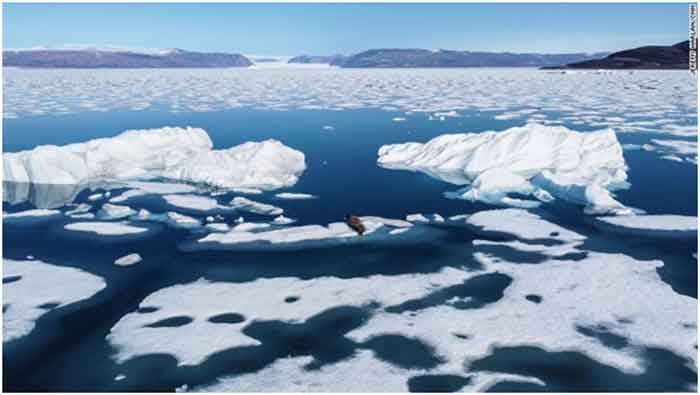
In Greenland, last weekend temperatures rose enough to cause 18 billion tons of the country’s ice sheet to melt over three days.
Scientists have warned about the fate of Greenland’s ice sheet.
Scientists say what happened between July 15 and 17 is the latest massive melting event contributing to an increase in the global sea level.
The amount of water from the melt – about 6 billion tons a day, or 18 billion tons over the weekend – is enough to “cover West Virginia in a foot of water – 4 inches per day, roughly,” Ted Scambos, a senior research scientist at the University of Colorado’s Earth Science and Observation Center and National Snow and Ice Data Center, told USA TODAY.
Much of the melting came from northern Greenland because warm air drifted over from the Canadian Arctic Archipelago, Scambos said.
There is also a high-pressure dome over Greenland. Together, they created an “unusually extensive melt event,” he said.
Temps Heating Up
Temperatures vary over Greenland, but the coldest temperatures are in areas of high elevation, toward the center of the ice sheet, said William Lipscomb, a senior scientist in the U.S. National Center for Atmospheric Research’s Climate and Global Dynamics Laboratory.
Once temperatures are above freezing or 32 degrees Fahrenheit, the melting begins. Temperatures last weekend were around 60 degrees, or 10 degrees warmer than normal for this time of year, according to CNN.
“In recent years, we have seen a lot of heat waves in Greenland, this recent warming of it being one example,” Lipscomb told USA TODAY. “Any temperature above freezing can cause some surface melting.”
Tremendous Amount Of Ice Lost Every Year Now
In the 1980s and 1990s in Greenland, a melt event of this sort never occurred, but starting in the 2000s – especially since 2010 – the melting has been more extensive.
The melt is two times larger than normal, said Xavier Fettweis of the University of Liège. Fettweis, a polar researcher, created a model scientists use, along with satellite data, to study Greenland’s changes.
The melt is among two of the largest melts in the ice sheet history after the 2012 and 2019 melting events; in 2019, the runoff was about 527 billion tons. So far, the total melt is far below 2019 levels, but the situation is more dire over the Svalbard ice caps at the North of Norway, Fettweis said.
More melting was expected, said Scambos. “This event is one of many events over the whole summer,” he said. “We can expect on the order of 100 billion tons of water going into the ocean. Greenland as a whole is losing a tremendous amount of ice every year now.”
NASA Goddard Space Flight Center ice scientist Nathan Kurtz was recently in Greenland to help better calibrate ICESat-2, one of the agency’s satellites used to monitor Greenland.
Its data has shown a loss of ice from Greenland of about 200 billion tons a year over the past two decades, Kurtz told USA TODAY. “This loss of ice contributes directly to global sea level rise, which has significant societal impacts,” he said.
Lipscomb said scientists measure the amount of water melted in units of gigatons per year, or 1 billion tons of water. Before climate change, about 600 gigatons of snowfall were coming in each year and about 300 gigatons were going out in the form of summer melting.
Now, Greenland’s ice sheet is losing nearly 300 gigatons of water each year more than it gains from snowfall, Lipscomb said. “There is still time to avoid catastrophic sea level rise, but every year that greenhouse gas emissions continue at the present rate increases the chances of serious problems down the road.”
In some parts of the world such as Asia, seasonal water supply depends on the timing of the glacier melt.
“If the melt is happening too early, you may not be getting the water when you need it for farming,” he said. “And if the glaciers completely melt, then you won’t have the glacier melt water source at all. And that’s something people worry about for later this century as the warming continues.”

A CNN report said:
The water off the coast of northwest Greenland is a glass-like calm, but the puddles accumulating on the region’s icebergs are a sign that a transformation is underway higher on the ice sheet.
Several days of unusually warm weather in northern Greenland have triggered rapid melting, made visible by the rivers of meltwater rushing into the ocean.
The amount of ice that melted in Greenland between July 15 and 17 alone would be enough to fill 7.2 million Olympic-sized swimming pools, according to data from the U.S. National Snow and Ice Data Center.
“The northern melt this past week is not normal, looking at 30 to 40 years of climate averages,” said Ted Scambos, a senior research scientist at the National Snow and Ice Data Center at the University of Colorado. “But melting has been on the increase, and this event was a spike in melt.”
For the scientists out on the ice sheet, the warmth has been alarming.
“It definitely worries me,” said Kutalmis Saylam, a research scientist with the University of Texas who is currently stationed in Greenland. “Yesterday we could wander around in our t-shirts — that was not really expected.”
Each summer, scientists worry that they will see a repeat of the record melting that occurred in 2019, when 532 billion tons of ice flowed out into the sea. An unexpectedly hot spring and a July heat wave that year caused almost the entire ice sheet’s surface to melt. Global sea level rose permanently by 1.5 millimeters as a result.
Greenland holds enough ice — if it all melted — to lift sea level by 7.5 meters around the world.

The latest research points to a more and more precarious situation on the Northern Hemisphere’s most icy island.
“Unprecedented” rates of melting have been observed at the bottom of the Greenland ice sheet, a study published in February found, caused by huge quantities of meltwater trickling down from the surface. This water is particularly concerning because it can destabilize the sheet above it and could lead to a massive, rapid loss of ice.
And in 2020, scientists found that Greenland’s ice sheet had melted beyond the point of no return. No efforts to stave off global warming can stop it from eventually disintegrating, said researchers at The Ohio State University. The rate of melting in recent years exceeds anything Greenland has experienced in the last 12,000, another study found — and enough to cause measurable change in the gravitational field over Greenland.
At the East Greenland Ice-core Project — or EastGRIP — research camp in northwest Greenland, the work of scientists to understand the impact of climate change is being thwarted by climate change itself.
Aslak Grinsted, a climate scientist at the University of Copenhagen’s Niels Bohr Institute, told CNN that they have been trying to get flights into the camp so they can ship out the ice cores they have recently collected. But the warmth is destabilizing the landing site.
“The temperatures we are seeing right now are simply too hot for the ski-equipped planes to land,” Grinsted said. “So we store the ice cores in large artificial caves we have made into the snow to protect it from the heat of the summer.”
Scientists take advantage of the abnormal warmth while they wait, playing volleyball in their shorts on an ice sheet at the top of the world.
Before human-caused climate change kicked in, temperatures near 32 degrees Fahrenheit there were unheard of. But since the 1980s, this region has warmed by around 1.5 degrees Fahrenheit per decade — four times faster than the global pace — making it all the more likely that temperatures will cross the melting threshold.
Grinsted referred the temperatures at the EastGRIP research site as a “heat wave,” and noted that global warming is pushing the mercury higher more often.
“Yes, the chance of temperatures getting this hot is clearly linked to global warming,” Grinsted said.
















































